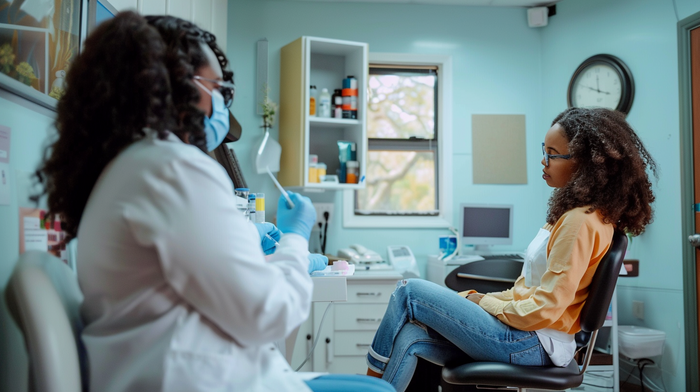Key points
- Allergy testing helps identify allergens to prevent allergic reactions and improve quality of life.
- Common types of allergy tests include skin prick testing, blood testing, and patch testing.
- Healthcare providers perform allergy tests to develop personalized treatment plans and determine eligibility for allergy shots or immunotherapy.
- Allergy symptoms range from mild to severe and can occur immediately or several hours after exposure to an allergen.
- If an allergy test is positive, a prevention plan is developed, which could involve avoiding the allergen, taking prescribed medications, or receiving allergy shots.

Allergy testing is used to identify things that you may be allergic to, like pollen, ragweed, certain grasses and trees, and even foods. Allergy testing is important because it can help you understand what to avoid reduce your risk of having an allergic reaction and improve your quality of life. For some people, a severe allergic reaction (called anaphylaxis) is life-threatening — and avoiding triggers is extremely important.
What Is an Allergy Test?
According to the Mayo Clinic, allergy testing is a procedure used to identify an allergic reaction to specific substances, including:
-
Foods
-
Different trees, grasses, and pollens
-
A variety of molds and fungi
-
Medications and other chemical compounds
They also note that there are several different types of allergy tests available, including skin prick testing, blood testing, and patch testing. The most common of these are skin prick testing and blood testing.
What Are the Types of Allergy Tests?
There are four allergy tests that are commonly used, according to the American Academy of Allergy, Asthma Immunology (AAAAI). Your primary care doctor may order a blood test to obtain IgE serum levels in the office. However, if referred to an allergist, you can expect them to conduct further testing, which usually involves a skin test.
Skin tests include skin prick testing, intradermal testing, and patch testing. An allergist will obtain your history and determine that it is safe and appropriate to perform the skin test.
Skin Prick Testing
The skin prick test is the most common type of skin test. According to the AAAAI, during skin prick testing, small amounts of the allergen (the substance suspected to cause the allergic reaction) are placed below the skin’s outer layer using a special device. Skin tests are typically done in an allergist’s office by a trained professional who understands the procedure and associated risks. These tests are less expensive than blood tests, and the results are faster, within 20 to 30 minutes, reports the AAAAI. At the end of the test, the allergist will read and grade the results.
Allergy Intradermal Testing
Intradermal testing is usually done to test for an allergy to insect stings or penicillin. The AAAAI reports that during the intradermal testing, a much higher amount of the allergen is injected within or into the skin with a thin needle. The result is read as positive if a wheal larger than 5 mm is formed, adding the AAAAI. Your allergist may perform an intradermal skin test to confirm a negative skin prick test.
Allergy Patch Testing
A patch test is a type of allergy test used to identify specific allergens that may be causing a delayed-type hypersensitivity reaction, such as contact dermatitis. According to the American Academy of Dermatology, patch testing is used to identify potential allergens found in everyday products, like cosmetics, fragrances, and hair dyes. During a patch test, small amounts of potential allergens are placed on patches and then applied to the skin for a period of time, usually 48 to 72 hours, adds the American Academy of Dermatology. The patches are then removed, and the skin is observed for a reaction.
Allergy Blood Testing
An allergy blood test is done by collecting blood samples and sending them to the lab for analysis. The AAAAI reports that a blood test is helpful if you cannot stop taking antihistamines, have a skin condition that may interfere with a skin test, or cannot endure the skin prick test.
Your allergist will specify antibodies for testing and run them with other similar allergens in panels. This test is often more expensive than skin tests. The waiting time for results is long, and you may test positive even if you have no allergies.
Why Do Healthcare Providers Perform Allergy Tests?
Healthcare providers perform allergy tests to identify specific allergens that may be causing a patient's allergic reactions. By identifying these allergens, healthcare providers can develop a treatment plan to help you manage your allergy symptoms.
Allergy tests can also help healthcare providers determine if a patient is a candidate for allergy shots or immunotherapy, according to the AAAAI.
How Do I Know If I Need an Allergy Test?
Allergies can cause a wide range of symptoms that vary depending on the type of allergen, the severity of the allergy, and each individual's immune system. According to the American Academy of Allergy, Asthma, and Immunology (AAAAI), some common symptoms of allergies include:
-
Sneezing
-
Runny or stuffy nose
-
Itchy or watery eyes
-
Skin rash or hives
-
Itchy throat or mouth
-
Coughing
-
Shortness of breath
-
Chest tightness
-
Swelling of the face, tongue, or throat
-
Abdominal pain, diarrhea, or vomiting
The AAAAI reports that According to the American Academy of Allergy, Asthma, and Immunology, the symptoms of an allergy can range from mild to severe and can occur immediately after exposure to an allergen or several hours later. It is important to seek medical attention if symptoms are severe or if there is any difficulty breathing.
How Should I Prepare for an Allergy Test?
Some allergy testing requires you to refrain from taking any allergy medication, including antihistamines, according to the American Academy of Allergy, Asthma, and Immunology. Your healthcare provider will be able to give you more information on how to prepare for your testing.
What Should I Expect During an Allergy Test?
The level of pain or discomfort associated with skin prick testing can vary depending on the individual's pain threshold and the specific area of the skin being tested, according to the AAAAI. In some cases, a topical anesthetic may be applied to the skin to minimize discomfort during the test. Some people may feel a slight stinging sensation or mild itching, while others may experience more significant discomfort or pain. It is important to note that the pain or discomfort associated with skin prick testing is generally mild and brief, and most people tolerate the procedure well.
After skin prick testing, it is common to experience some mild itching, redness, or swelling at the site of the test for a short period of time, usually up to an hour or two. In some cases, symptoms may last for a few hours or up to a day, according to the AAAAI. In some cases, your allergist may recommend taking an antihistamine after the procedure is complete.
Allergy Test Results
If you test positive for any part of your allergy test, the allergist will develop a plan to prevent and treat your symptoms.
Prevention plans described by the American College of Allergy, Asthma, and Immunology include avoiding or limiting contact with the allergen. For example, the allergist may instruct you to reduce clutter in your home to prevent dust if you are allergic to dust mites and avoid insects or certain types of food if you are allergic to them.
The allergist may also prescribe medications to treat your symptoms such as antihistamines. If you cannot avoid the allergens, your allergist may recommend allergy shots with gradual increments of the allergen to reduce your sensitivity. Your allergist may also prescribe an epinephrine auto-injector if you are at risk for a severe and life-threatening allergic reaction.
What is the cost of an allergy test?
The cost of allergy testing in the USA can vary widely depending on the type of test, the location, the provider, and insurance coverage. Average costs according to the Healthcare Bluebook, a website that provides estimates of fair prices for healthcare services, the price ranges from a couple of hundred dollars to several thousand dollars.
FAQs
What is the purpose of allergy testing?
Allergy testing is performed to identify substances that cause allergic reactions, helping individuals avoid these allergens and manage their symptoms.
What are the common types of allergy tests?
The most common types of allergy tests are skin prick testing, blood testing, and patch testing. Each test has a different method and application.
How can allergy testing help in treatment?
By identifying specific allergens, healthcare providers can develop a treatment plan to manage symptoms. This might include medication, allergy shots, or advice on avoiding the allergen.
What are the symptoms that might indicate the need for an allergy test?
Symptoms like sneezing, runny nose, itchy eyes, skin rash, coughing, shortness of breath, and swelling of the face can indicate the need for an allergy test.
How much does an allergy test cost?
The cost of allergy testing can vary widely, ranging from a few hundred dollars to several thousand dollars, depending on the type of test and insurance coverage.
Is allergy testing painful?
Allergy testing may cause some discomfort, but it's usually mild and brief.
What is the cost of allergy testing?
The cost of allergy testing can vary greatly, depending on several factors such as the type of test, location, and insurance coverage.
How can allergy testing improve my quality of life?
Allergy testing can improve your quality of life by helping you identify specific allergens. This knowledge can help you avoid triggers and manage symptoms effectively.






![Accident Prone: Common Holiday Accidents [INFOGRAPHIC]](https://ucl-cdn-prod.thirdparty.solvhealth.com/dir/media/W1siZiIsIjIwMTMvMTAvMjYvMTBfNTJfMTRfMjQ1X2hvbGlkYXlfYWNjaWRlbnRzLnBuZyJdLFsicCIsInRodW1iIiwiMzAweCJdXQ?sha=ace44d1b024a1586)


